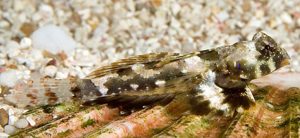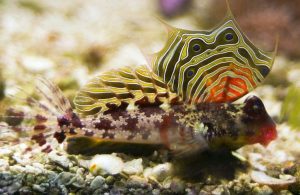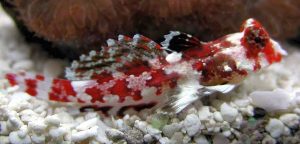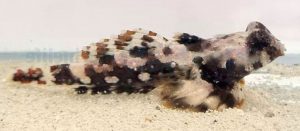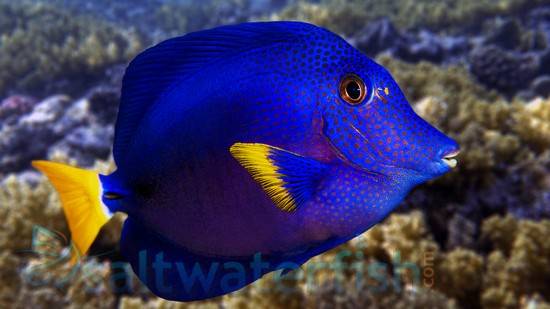The Scooter Blenny (Synchiropus ocellatus) known to tropical fish keeping enthusiasts as the Ocellated Dragonet, Scooter dragonet, Red scooter dragonet, Red scooter blenny, Starry dragonet, or Stellate dragonet is found in the southwest Pacific Ocean from southern Japan to the Marquesan Islands.
The Scooter Blenny, actually a dragonet (not part of the blenny family) is a peaceful, bottom dwelling species that is found in coral rich areas of the shallower coastal reefs, sandy lagoons, and seaward reef slopes of their range among sandy or rubble substrates at depths to 90 feet.
The Scooter Blenny is a peaceful, solitary species that will often form loose groups or “harems”. They generally do not stake off territories and can be found over wide areas on and just off the bottom.
Like other carnivorous dragonets, the Scooter Blenny spends its day “scooting” along the bottom with its specialized, wing like pectoral fins feeding on small crustaceans, invertebrates, Copepods, zooplankton, and other micro fauna.
The Scooter Blenny has a leaner, more streamlined body than most other dragonets and an intricately mottled body pattern that consists of various shades of tan, brown, black or rust across the body interspersed with lighter spots, dashes, and splotches of brighter colors.
They have small expressive eyes on top of their head, sensory barbells to detect their prey, and pointed snouts with small specialized mouths to extract their food from the sand and rubble rock.
Although their overall coloration is subdued and earthy, males when confronted by other males, especially during the breeding season, will display their large bright orange dorsal fins and exhibit brighter, more vivid colors.
The much sought after red Scooter Blenny color variant in particular, is deeper and more intensely colored.
Males have a larger dorsal fin, are larger than females, and are generally more brightly colored.
The Scooter Blenny is a peaceful species that does best in a reef tank or FOWLR aquarium of at least 30 gallon capacity that has matured at least 6 to 8 months, with a deep live sand substrate and copious amounts of live rock arranged into caves, overhangs and crevices for them to hop around, explore, and graze from. Moderate lighting to replicate their natural living conditions and an efficient filtration system with a good protein skimmer is necessary to maintaining stable water parameters. This species benefits greatly from a refugium sump liberally stocked with amphipods and copepods.
Because all dragonets are superb jumpers, a tight fitting cover is recommended.
Although the Scooter Blenny is generally a very peaceful fish that does well with others of their own kind, they should be introduced into the tank at the same time at a ratio of 2 to 3 females per male.
When keeping more than one male Synchiropus ocellatus or more than a single species: a larger tank of at least 55 gallon capacity with a deep layer of live sand is needed to provide the space and the food source they need to thrive.
Scooter Blennies get along well with other similarly sized, non aggressive species such as Clownfish, Lawnmower Blennies, Mandarin Gobies, Green Blennies, Watchman Gobies, Dwarf Angelfish, non predatory Invertebrates like Fire and Cleaner Shrimp, Snails, Hermit Crabs, etc. .
Avoid housing them with larger, aggressive species and Anemones that could make a meal of them.
The Scooter Blenny has been bred in an aquarium environment however, but raising the fry is extremely challenging.
Spawning usually occurs during the evening as the sun sets. When ready to spawn, the Scooter Blenny pair will begin a courtship ritual by linking their fins together and swimming together towards the surface from above the sand. With their fins locked, just before reaching the surface, the pair will split apart and go back to the substrate to repeat the ritual. This can happen multiple times before the final trip to the surface that culminates in the simultaneous release of gametes. The eggs hatch around 12 to 16 hours after fertilization, and the fry usually finish absorbing their yolk sacs another 36 hours later. The tiny Scooter Blenny fry are extremely small and require the same food as their parents.
Tisbee Pods, Rotifers, baby brine shrimp, Mysis shrimp, and other tiny, protein rich offerings can be fed to the tiny fry.
The biggest challenge is feeding the fry without fouling the water from uneaten food. You will need to perform daily 25-50% water changes without draining the micro fauna food supply that the fish need for survival from the rearing tank.
In their natural environment, Scooter Blennies are constantly foraging on small Zooplankton, amphipods, copepods and other micro fauna.
In a well established aquarium environment, their primary food source is the steady supply of live copepods and amphipods from the live sand and live rock in the aquarium and refugium. Although live copepods provide essential nutrients and help maintain their natural foraging behavior, Tisbee Pods, Tisbe biminiensis, and supplemental offerings of frozen Zooplankton, bloodworms, glassworms, Mysis shrimp, brine shrimp, marine algae, and nori can also be offered.
The Scooter Blenny (Synchiropus ocellatus) is commonly available to tropical fish keeping enthusiasts as wild caught or aquacultured specimens from online retailers, wholesalers, and transhippers at reasonable prices that vary on size and area of collection.
Prices for approximate purchase sizes: Small: 1″ to 2″ $24.99; Medium: 2″ to 3″ $33.99; Large: 3″ to 5″ $39.99.
.
Minimum Tank Size: 30 gallon (55+ gallons for multiple pairs)
Aquarium Type: Reef or FOWLR
Care Level: Difficult
Temperament: Peaceful
Aquarium Hardiness: Hardy when acclimated
Water Conditions: 72-78° F, dKH 8 – 12°, pH 8.1–8.4, sg 1.023-1.025
Max size: 5″
Color Form: Red, White, Tan, Black
Diet: Carnivore
Compatibility: Reef Safe
Origin: Indonesia, Philippines
Family: Callionymidae
Lifespan: 2 – 4 years
Aquarist Experience Level: Intermediate


